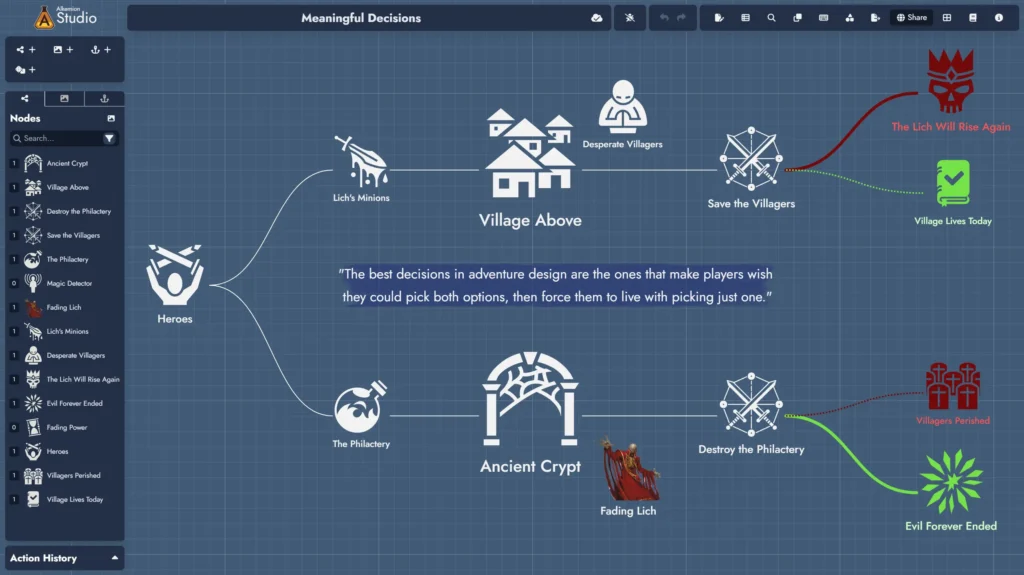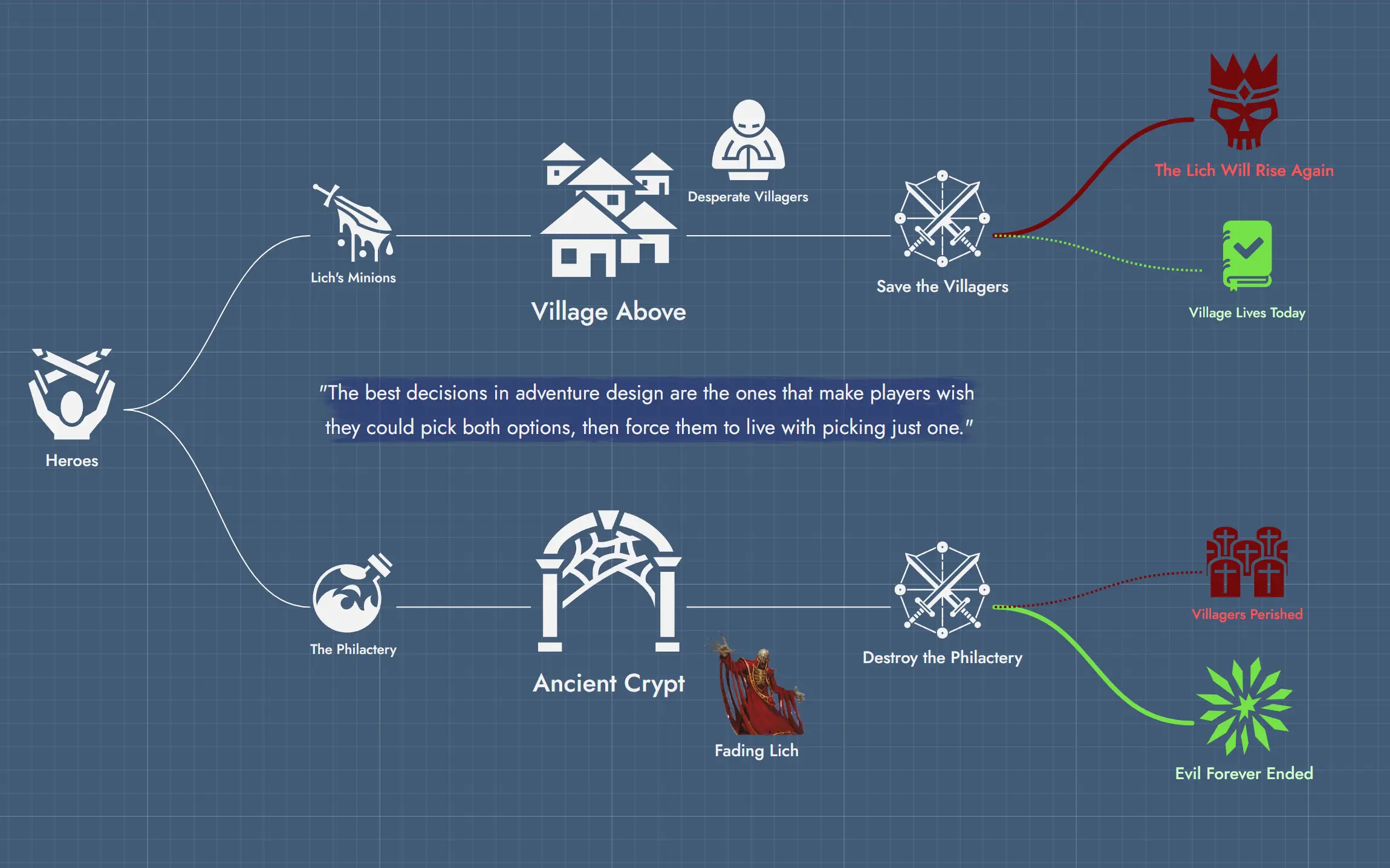There’s a peculiar form of paralysis that strikes at gaming tables across the world. The party has just arrived in a bustling metropolis, and the GM leans back in their chair, eyes gleaming with anticipation, and asks that most dreaded of open-ended questions: “What would you like to do?” And so the players sit there, frozen in the headlights of infinite possibility, while the pizza grows cold and everyone’s souls slowly leak out through their ears.
Consider the difference between these two scenarios:
“What would you like to do in town?” (A question that opens up too many possibilities without meaningful stakes)
Versus:
“The ancient lich’s phylactery lies before you, but you hear the screams of villagers being slaughtered by the lich’s minions above. Your magic detector indicates the phylactery’s power is fading: if you don’t destroy it now, the lich will reform elsewhere. But those screams are getting more desperate. What do you do?”
That’s a real decision. It matters. It hurts. It creates stories.
The Power of Creative Constraints
While the toolbox of modern gaming offers many ways to create open-ended stories together, there’s a beautiful paradox in game design: meaningful constraints often spark the most creative solutions. When everything is possible, nothing matters. But when players face genuinely thorny dilemmas (rescue the hostages or secure the magical artifact, negotiate with the dragon or risk combat, trust the suspicious ally or expose their treachery), that’s when the game catches fire.

Every significant choice needs downsides. The best decisions are the ones that make players wish they could pick both options, then force them to live with picking just one. When a paladin must choose between upholding their oath and saving an innocent life, it’s a moment that defines their character more than just a tactical choice. When a wizard decides whether to use forbidden magic to save their party, knowing it might corrupt them, that’s a decision that resonates with their personal journey.
The Architecture of Meaningful Choices
When I refer to meaningful decisions, I’m talking about having clear, consequential choices with real teeth. Like the classic dilemma of the party discovering that their trusted mentor, who’s been guiding them through a perilous political conflict, is actually working to undermine the very cause they’re fighting for. Do they expose him, knowing it could destabilize the entire resistance movement and put innocent lives at risk, or do they try to quietly redirect his influence while maintaining the facade of unity?
Players need enough information to make strategic choices, not just blind guesses. This doesn’t mean laying all your cards on the table, but rather providing enough context for tactical awareness. Choosing which wire to cut on a bomb is meaningless if you’re guessing blindly, but gripping if you’ve gathered clues about the bomber’s methods throughout your investigation.
These choices ripple through the campaign, creating new situations and complications. That merchant you decided to swindle might show up months later as an influential noble. The monster you spared might return with its entire clan, either as grateful allies or seeking revenge. These decisions echo through time, transforming seemingly minor choices into campaign-defining moments.
The Art of Triangular Design
This is where triangularity comes into play, a concept defined by Jesse Schell in The Art of Game Design, designed to elevate meaningful choices into exquisite dilemmas. It’s the eternal tension between the safe path with modest rewards versus the dangerous gambit with spectacular payoff. Consider a classic scenario where the party discovers a heavily guarded keep can be infiltrated in multiple ways: through the sewers (slow but safe), by scaling the walls during guard rotation (moderate risk and speed), or by magically disguising themselves as the baron’s expected guests (quick but incredibly risky if discovered).
Each path offers a different balance of risk and reward: the sewers guarantee eventual entry but consume precious time and resources, while impersonating the guests could get them straight to their target but risks immediate exposure if their deception fails. Both extremes and the middle path must be viable, but they ask different prices. Low risk for steady progress, or high risk for potential glory? When balanced properly, this tension creates decisions that make players’ palms sweat.
The Power of Consequences
Here’s where I think many GMs go wrong: they try to soften these decisions, to provide escape hatches and third options. They’re afraid of their players failing or feeling bad. Experience taught me that this is a mistake. At the table, failure is not the opposite of fun, it’s an essential ingredient. The possibility of failure is what gives success its savor.
The best decisions are the ones that make players wish they could pick both options, then force them to live with picking just one.
Another power of meaningful decisions reveals itself not in the moment of choice, but in what comes after. They’re about that pit in your stomach when you chose to destroy the phylactery and now must live with the knowledge of the villagers you couldn’t save. They’re about the quiet pride when your risky alliance with the former enemy pays off months later. They’re about those late-night conversations between players, long after the session has ended, still debating if they made the right call.
The Craft of Decision Design
The craft of creating meaningful decisions requires both careful preparation and improvisational skill. When designing these pivotal moments, start by establishing clear goals that exist in genuine tension with each other. Layer these choices with additional complexity. Perhaps securing the artifact first means gaining a powerful tool that could help save more lives in the future, while prioritizing the hostages maintains the party’s moral standing but lets a dangerous item slip into enemy hands.
Information is your scalpel for carving out meaningful decisions. Consider the difference between “You see tracks leading into the cave” and “You recognize two distinct sets of tracks: fresh hobgoblin boots heading in, and what appears to be someone being dragged out.” The second gives players specific information they can use to form strategies and make meaningful choices about their approach.
Your rulings as GM must maintain consistency for these choices to matter. When players understand how the game world operates, they can make decisions based on reasonable expectations rather than arbitrary whims. If you’ve established that certain actions have specific consequences, stick to those principles.
Finding the Pressure Points
Remember that not every moment needs to be a crucible of decision-making. The power of meaningful choices comes partly from their scarcity. Learn to identify the pressure points in your narrative where decisions will have the most impact, and focus your energy on making those moments sing.
When players lean forward in their chairs, dice clutched tight, agonizing over their options, that’s when you know you’ve created something special. That tension, that investment, that genuine uncertainty about the right path forward, these are the moments that transform a good game into an unforgettable one.
So next session, instead of opening up the infinite void of possibility, try closing some doors. Create pressure points. Force choices. Make them matter. Your players might sweat in the moment, but they’ll thank you later. Those are the games they’ll still be talking about years from now.



Leave a Reply